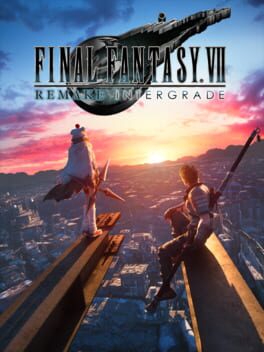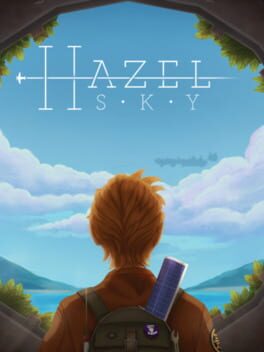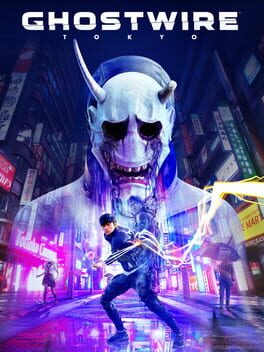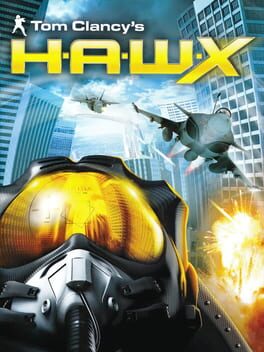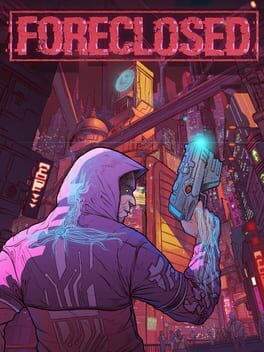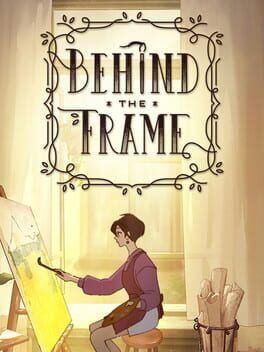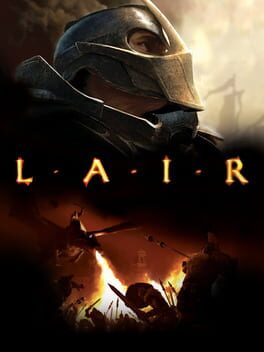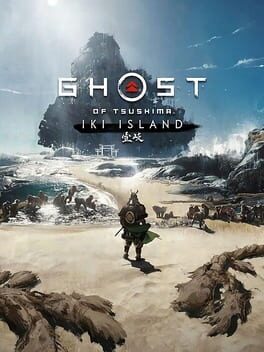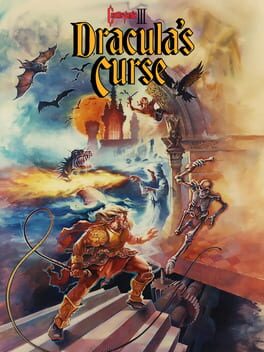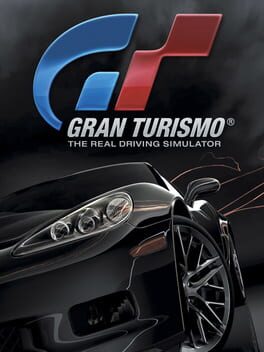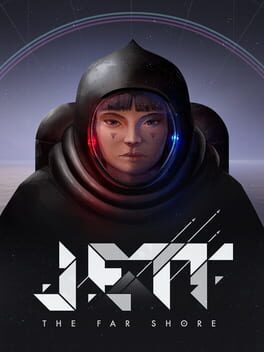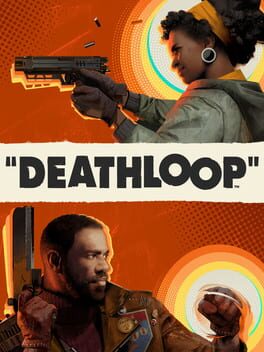bamdumtss
For me Intermission has one of the highest highs in FF7R, but also some of the more flat sections. The first half is pretty great, with a fun side mission around Fort Condor and an absolute banger of a gameplay section where a Jazz-influenced soundtrack plays the whole way through. The second half is unfortunately less exciting, as the game puts you in literal arenas, from one combat encounter to another combat encounter in a uninspiring manner, but thankfully it has pretty good boss fights. I really liked playing as Yuffie, and I thought the new synchronize mechanics with Sonon is pretty fun to play with, but unfortunately I didn't get to care too much about Sonon, as his story felt pretty by-the-numbers and his personality is only mildly interesting. The overall story is also just meh, felt like filler. The only important part is probably the ending cutscene. At least this doesn't overstay its welcome, at only 5-6 hours in length. It definitely wouldn't be as fun if Yuffie isn't here to carry the whole thing and be the energetic core of it all.
2022
Hazel Sky's heart is in the right place. It's basically a mini Uncharted 4, but without any combat sections, little cinematic flair, and with the minimum budget required to make it a functional and fun game. With most games these days being influenced by either Dark Souls or Zelda, it's refreshing to see a indie dev try this sort of third person game.
The game mostly consists of exploring small tropical islands in order to fix a machine that will get you to the next island. Along the way you will be solving light puzzles and searching for notes and keys that will help open the way forward. There are light traversal sections, including climbing, swinging on ropes, and even sliding down muddy cliffs (which is taken right out of Uncharted 4, and I don't mind it at all). The puzzles and traversal are overall on the simplistic side, but it's fun enough to keep you engaged during the game's short runtime, and they contribute to the game's relaxed vibe by never making you feel too frustrated.
There's collectibles that serve as world-building lore, which I thought is done decently here, as there are a good amount of interesting stuff that is being told, despite the broken English here and there. You can also play a guitar in certain locations, and there's songs the character can sing (which are actually pretty good) if you collect music notes and play the chord written in said notes.
Unfortunately the main story is lackluster, mostly let down by the horrendous voice acting (for the English voices) and a unsatisfying plot and writing. Every now and then you'll get to talk to Erin, a girl who's allegedly on the same quest as you are, and her voice and dialogues are just too annoying, not unlike a whiny child. The aforementioned minimal budget also shows in the janky and somewhat unpolished look of the game, especially with the character models (really bad faces!).
Still, I'm glad to support a third person game of this ilk, and I had fun with it despite my complaints. If you're like me and curious about the Uncharted influence here, it's worth a shot.
The game mostly consists of exploring small tropical islands in order to fix a machine that will get you to the next island. Along the way you will be solving light puzzles and searching for notes and keys that will help open the way forward. There are light traversal sections, including climbing, swinging on ropes, and even sliding down muddy cliffs (which is taken right out of Uncharted 4, and I don't mind it at all). The puzzles and traversal are overall on the simplistic side, but it's fun enough to keep you engaged during the game's short runtime, and they contribute to the game's relaxed vibe by never making you feel too frustrated.
There's collectibles that serve as world-building lore, which I thought is done decently here, as there are a good amount of interesting stuff that is being told, despite the broken English here and there. You can also play a guitar in certain locations, and there's songs the character can sing (which are actually pretty good) if you collect music notes and play the chord written in said notes.
Unfortunately the main story is lackluster, mostly let down by the horrendous voice acting (for the English voices) and a unsatisfying plot and writing. Every now and then you'll get to talk to Erin, a girl who's allegedly on the same quest as you are, and her voice and dialogues are just too annoying, not unlike a whiny child. The aforementioned minimal budget also shows in the janky and somewhat unpolished look of the game, especially with the character models (really bad faces!).
Still, I'm glad to support a third person game of this ilk, and I had fun with it despite my complaints. If you're like me and curious about the Uncharted influence here, it's worth a shot.
2022
Ghostwire Tokyo is a showcase of using tried-and-true methods with an unique flair in order to make a fresh yet familiar experience. There's nothing truly groundbreaking about the game, and yet it has tricks that aren't seen too often in the AAA gaming landscape.
This game shows how important the setting is in an open world game. Despite having a open world structure that is not unlike any other open world game we've seen (think of the classic Ubisoft style open worlds), the game thrives as it showcases its delightfully designed rendition of Tokyo. Whether in exploration, combat, or story-related activities, Tokyo never escapes the spotlight. It's a breath of fresh air amongst all the big-in-size-but-empty-wasteland open worlds, and also the car-centric American cities that tend to be the backdrop in most modern open world games. Instead of mostly driving cars through big roads to traverse the city, you'll be walking on tight streets, and also glide from roof to roof. Especially later in the game when you're truly familiar with all the abilites you have, exploring the ups and downs and the nooks and crannies of Tokyo is not only a rewarding experience on its own, but also through how the developers reward your curiosity by well placed rewards, mostly in the form of Meika coins that you can use to buy items.
Combat is simple yet satisfying. It's about being aware of your surroundings, managing the space between you and your enemies, and seizing the opportunity when you can deal massive damage at once. You'll mostly shoot various energy beams towards the enemies, and you can parry attacks if things get too hectic, but it's a tricky thing to master. There are also talismans with specific uses later on, such as a talisman that can expose the core of your enemies, making them instantly available to kill. These talismans are mostly earned by buying them at stores, and they can drain your cash if you rely on them too much. You can also use a bow to hit enemies stealthily from afar. Many people will feel that the combat is too simplistic for their liking, but for me, the flashiness of it and the challenging difficulty (on Hard) is more than enough to keep it engaging throughout the whole game.
The main plot is pretty basic, but it certainly has its emotional moments, especially in the later half of the game. The game is mostly about the character interactions and the side stories you'll stumble upon. The relationship development between the two main characters (Akito and KK) are simply a joy to watch, and they form the charming core of the game. As the game goes they will learn to open up to each other, making way for entertaining dialogues. There are also various side characters that are memorable, despite not being as developed as the main characters.
Another big part of the game is how it treats Japanese culture with so much respect. Obviously the story of the game is drenched in Japanese folklore, but it doesn't end there. It is shown through all the side missions, the collectibles, and so on. A lot of the stories in the side mission deal with some sort of Japanese supernatural elements, such as dealing with cursed artifacts, or ending a long-lasting grudge. All the collectibles (and also other items such as consumables) are accompanied with flavor text which can be quite educational in Japanese culture. The game also presents Japanese demons or Yokais in its own charming way, and it's a delight to interact with them. If you don't like the nekomatas that are guarding the shops, then you're just not a good person.
Visually the game is quite mesmerizing. The rain-soaked streets of night time Tokyo is a charming beauty indeed. Not to mention many of the enemies and Yokais are beautifully designed, with their own personalities and levels of creepiness. The flashy energy effects and animations of your hands also adds a lot to the excitement of combat. There are also segments in some main and side missions where you are transported to unnatural locations, and these are their own showcases of visual splendor to experience. Lastly, the models of the dogs and cats aren't too great, but they remain as adorable as ever.
Still, the game has a lot of flaws. Some buildings have questionable climbable sections, making you fall down to the street because you don't know which part of the building to glide to. There could be a lot more done to make the progression system more exciting, because it's mostly simple upgrades such as 10% boost on fire rate. The variety of offensive and defensive abilities could also be improved, maybe by adding a dedicated dodge move, or adding melee combo moves. Managing consumables is not very intuitive. The music can be too ambient at times, making it quite forgettable. The performance on PS5 is not yet perfect even on the latest patch. And yet, I don't think these flaws are enough to drag the game down too much.
In the end, Ghostwire Tokyo is a truly memorable open world experience. It feels like a PS2-era semi-experimental game, except this game doesn't fully rely on the charm of its uniqueness alone. It has quality execution to back up most of its great ideas. In a way, the game uses familiar mechanics and ideas from other games to not only support its main ideas, but also as a contrast in order to make them stand out even more.
This game shows how important the setting is in an open world game. Despite having a open world structure that is not unlike any other open world game we've seen (think of the classic Ubisoft style open worlds), the game thrives as it showcases its delightfully designed rendition of Tokyo. Whether in exploration, combat, or story-related activities, Tokyo never escapes the spotlight. It's a breath of fresh air amongst all the big-in-size-but-empty-wasteland open worlds, and also the car-centric American cities that tend to be the backdrop in most modern open world games. Instead of mostly driving cars through big roads to traverse the city, you'll be walking on tight streets, and also glide from roof to roof. Especially later in the game when you're truly familiar with all the abilites you have, exploring the ups and downs and the nooks and crannies of Tokyo is not only a rewarding experience on its own, but also through how the developers reward your curiosity by well placed rewards, mostly in the form of Meika coins that you can use to buy items.
Combat is simple yet satisfying. It's about being aware of your surroundings, managing the space between you and your enemies, and seizing the opportunity when you can deal massive damage at once. You'll mostly shoot various energy beams towards the enemies, and you can parry attacks if things get too hectic, but it's a tricky thing to master. There are also talismans with specific uses later on, such as a talisman that can expose the core of your enemies, making them instantly available to kill. These talismans are mostly earned by buying them at stores, and they can drain your cash if you rely on them too much. You can also use a bow to hit enemies stealthily from afar. Many people will feel that the combat is too simplistic for their liking, but for me, the flashiness of it and the challenging difficulty (on Hard) is more than enough to keep it engaging throughout the whole game.
The main plot is pretty basic, but it certainly has its emotional moments, especially in the later half of the game. The game is mostly about the character interactions and the side stories you'll stumble upon. The relationship development between the two main characters (Akito and KK) are simply a joy to watch, and they form the charming core of the game. As the game goes they will learn to open up to each other, making way for entertaining dialogues. There are also various side characters that are memorable, despite not being as developed as the main characters.
Another big part of the game is how it treats Japanese culture with so much respect. Obviously the story of the game is drenched in Japanese folklore, but it doesn't end there. It is shown through all the side missions, the collectibles, and so on. A lot of the stories in the side mission deal with some sort of Japanese supernatural elements, such as dealing with cursed artifacts, or ending a long-lasting grudge. All the collectibles (and also other items such as consumables) are accompanied with flavor text which can be quite educational in Japanese culture. The game also presents Japanese demons or Yokais in its own charming way, and it's a delight to interact with them. If you don't like the nekomatas that are guarding the shops, then you're just not a good person.
Visually the game is quite mesmerizing. The rain-soaked streets of night time Tokyo is a charming beauty indeed. Not to mention many of the enemies and Yokais are beautifully designed, with their own personalities and levels of creepiness. The flashy energy effects and animations of your hands also adds a lot to the excitement of combat. There are also segments in some main and side missions where you are transported to unnatural locations, and these are their own showcases of visual splendor to experience. Lastly, the models of the dogs and cats aren't too great, but they remain as adorable as ever.
Still, the game has a lot of flaws. Some buildings have questionable climbable sections, making you fall down to the street because you don't know which part of the building to glide to. There could be a lot more done to make the progression system more exciting, because it's mostly simple upgrades such as 10% boost on fire rate. The variety of offensive and defensive abilities could also be improved, maybe by adding a dedicated dodge move, or adding melee combo moves. Managing consumables is not very intuitive. The music can be too ambient at times, making it quite forgettable. The performance on PS5 is not yet perfect even on the latest patch. And yet, I don't think these flaws are enough to drag the game down too much.
In the end, Ghostwire Tokyo is a truly memorable open world experience. It feels like a PS2-era semi-experimental game, except this game doesn't fully rely on the charm of its uniqueness alone. It has quality execution to back up most of its great ideas. In a way, the game uses familiar mechanics and ideas from other games to not only support its main ideas, but also as a contrast in order to make them stand out even more.
This game does not hold up. It's pretty fun up until the Jerusalem level where it just took a massive nose dive in terms of fun level design. The story is as plain as you would expect from a Tom Clancy game. The PS3 port job didn't do the game any favors too, with bad framerates for 80% of the game and some visual glitches here and there.
2009
This game is pretty lame. Boring "story", bland "characters", flat presentation, uninspired mission designs, and so on. The core gameplay of it is decent, with solid aircraft controls and satisfying kill feedback (explosions and sound effects and such). There's just nothing interesting other than that. I do appreciate the game trying out something different with the Assistance OFF mode.
2021
If you watched the trailers for this game, you might be deterred from trying it out like I did. The idea of a traditional third person shooter gameplay-wise is appealing to me, as a fan of those kind of games that was so prevalent back in the PS3/360 era. As luck would have it, it's available on PS Plus Extra, and after finishing the game, I'm glad to say that there's a worthwhile albeit flawed game here.
The main star of the game for me is the presentation. The cell-shaded graphics looks appealing enough, and the comic book panel framings that the game does occasionally is quite well done, with smooth transitions and eye-pleasing camera angles. The voice acting and writing are also pretty decent, which is not what I expected. It goes to show that indie developers can achieve a lot with relatively little these days.
The story is about a man with noir-esque hard boiled qualities, mostly shown through his entertaining VO and dialogues, fighting for his life as insidious third parties take a shot at him for unknown reasons. It's engaging enough to pay attention to, especially with the stylish presentation, although it's nothing special.
The game plays mostly as a third person shooter. You mostly use your one and only technologically advanced pistol that you can upgrade as you earn XP by killing enemies and finding hidden XP cache. You also have abilities such as slamming an enemy down and a temporary shield, all of it needs to be unlocked by either XPs or getting to specific parts of the story. The upgrades for the gun include automatic high fire rate and armor piercing bullets. While they are certainly useful, the progression feels quite linear because there are not many upgrades, and in the later parts of the game it will feel like you have to install certain gun upgrades all the time in order to avoid having too much trouble. The abilites does provide more room for self-expression as you unlock more of them. They can provide the same effects to enemies as some of the gun upgrades, and thus freeing some room for other gun upgrades to be installed. There's also a overheat system where you can be temporarily stunned if you use too many abilities in a short time period, and this applies to your gun upgrades as well. This forces a bit more thought to the gameplay because you can't just pick and use the most useful upgrades/abilites all the time.
The gunplay encounters are okay, it's mostly just waves of enemies coming at you. The level design awkwardly supports cover-based gameplay (although the game doesn't have a cover system), with sparsely placed cover here and there. The enemy AI will be aggressive if you stay in one place, but the level design makes their path of approach very predictable since the levels are quite small in size. The enemy types is not too varied too. In a bigger game, these are potentially fatal problems, but since the game is so short (3 hours) and it doesn't only rely on combat, they never really snowballed to become an annoyance.
The stealth sections are mostly very loose. It reminds me of the stealth in Naughty Dog's first three Uncharted games, where it feels like stealth is not what the game is designed for, and yet you can still do them in certain situations. It does have a few dedicated sections where if you're seen even once you'll fail the game, and these sections are actually pretty fun.
The puzzles mostly involve you roaming around the map looking for specific objects to interact with using sonar radar-esque tool. It's nothing to write home about, it does its job to vary up the gameplay and nothing more.
Overall, Foreclosed is a enjoyable attempt at a story driven third person action adventure game. While there's nothing too special here, the short-and-sweet nature of the game makes for a decent one-sitting experience. It scratches a very specific itch as I describe at the very beginning, and if you care for that at all then it's worth a shot.
The main star of the game for me is the presentation. The cell-shaded graphics looks appealing enough, and the comic book panel framings that the game does occasionally is quite well done, with smooth transitions and eye-pleasing camera angles. The voice acting and writing are also pretty decent, which is not what I expected. It goes to show that indie developers can achieve a lot with relatively little these days.
The story is about a man with noir-esque hard boiled qualities, mostly shown through his entertaining VO and dialogues, fighting for his life as insidious third parties take a shot at him for unknown reasons. It's engaging enough to pay attention to, especially with the stylish presentation, although it's nothing special.
The game plays mostly as a third person shooter. You mostly use your one and only technologically advanced pistol that you can upgrade as you earn XP by killing enemies and finding hidden XP cache. You also have abilities such as slamming an enemy down and a temporary shield, all of it needs to be unlocked by either XPs or getting to specific parts of the story. The upgrades for the gun include automatic high fire rate and armor piercing bullets. While they are certainly useful, the progression feels quite linear because there are not many upgrades, and in the later parts of the game it will feel like you have to install certain gun upgrades all the time in order to avoid having too much trouble. The abilites does provide more room for self-expression as you unlock more of them. They can provide the same effects to enemies as some of the gun upgrades, and thus freeing some room for other gun upgrades to be installed. There's also a overheat system where you can be temporarily stunned if you use too many abilities in a short time period, and this applies to your gun upgrades as well. This forces a bit more thought to the gameplay because you can't just pick and use the most useful upgrades/abilites all the time.
The gunplay encounters are okay, it's mostly just waves of enemies coming at you. The level design awkwardly supports cover-based gameplay (although the game doesn't have a cover system), with sparsely placed cover here and there. The enemy AI will be aggressive if you stay in one place, but the level design makes their path of approach very predictable since the levels are quite small in size. The enemy types is not too varied too. In a bigger game, these are potentially fatal problems, but since the game is so short (3 hours) and it doesn't only rely on combat, they never really snowballed to become an annoyance.
The stealth sections are mostly very loose. It reminds me of the stealth in Naughty Dog's first three Uncharted games, where it feels like stealth is not what the game is designed for, and yet you can still do them in certain situations. It does have a few dedicated sections where if you're seen even once you'll fail the game, and these sections are actually pretty fun.
The puzzles mostly involve you roaming around the map looking for specific objects to interact with using sonar radar-esque tool. It's nothing to write home about, it does its job to vary up the gameplay and nothing more.
Overall, Foreclosed is a enjoyable attempt at a story driven third person action adventure game. While there's nothing too special here, the short-and-sweet nature of the game makes for a decent one-sitting experience. It scratches a very specific itch as I describe at the very beginning, and if you care for that at all then it's worth a shot.
I cannot recommend this game enough. At first, I was lulled in by the game's absolutely beautiful Ghibli-inspired art style and the lovely jazz music, and I was enjoying it. Then, at a certain point, the game suddenly got more interesting, and by the end, tears poured out of my eyes and I just can't help it.
This game is quite simple in premise and gameplay. It's a point and click adventure, with easy puzzles primarily revolving around adding missing colors to missing paintings. The game is more about the story and atmosphere, and the simplicity of it's gameplay helps you to appreciate the game's strength even more.
At less than 2 hours in length, there is simply not much to talk about without spoiling it, so I will end it with this: this game would have been a wonderful short film, but as a game, it becomes something that is truly special.
This game is quite simple in premise and gameplay. It's a point and click adventure, with easy puzzles primarily revolving around adding missing colors to missing paintings. The game is more about the story and atmosphere, and the simplicity of it's gameplay helps you to appreciate the game's strength even more.
At less than 2 hours in length, there is simply not much to talk about without spoiling it, so I will end it with this: this game would have been a wonderful short film, but as a game, it becomes something that is truly special.
2007
As someone who only played games casually back in the early PS3 days, I never truly understood how badly this game was received back in the day. When I (somewhat) recently heard that the game got an update that added analog controls, I immediately bought an used copy and give it a try. I thought that most of the game's problems would be solved by that patch, and I would have a fun time being a badass dragon rider. Turns out, there's much more dust and dirt beneath the frame.
Before we continue, I want to say that I didn't finish the game. I have reached a bit past the halfway point, and couldn't muster the energy to keep playing it.
First off, I thought that the story and lore of the world was pretty engaging. Long lasting grudges, religious undertones, betrayals; this game has it all. It's a decent fantasy world, and it was one of the things that kept me going.
The problem is, of course, regarding the gameplay. The game's performance is simply abysmal, with screen tears and framerate drops being a normal part of the experience. Controlling the dragon can feel quite satisfying at times, but also downright infuriating as it refuses to exactly behave as you wanted. There's also these mini QTE sections where you can face off directly against an enemy dragon, and the camera will lock in to show both of you flying side by side, trying to hit one another directly. These sections are still controlled by the motion sensor, so it will inevitably cause problems.
There's also a difficulty problem, where some levels are much harder than the other ones. It's not even the good kind of difficulty (challenging enemies or bosses, etc), it's mostly because the objectives are obtuse and the game doesn't tell you exactly what needs to be done. This is worsened by the horrible controls.
Still, there are a few good parts in this game. The soundtrack is very underrated, and I would recommend you to listen to it on your own. There's also a couple missions that are just so close to becoming great, but held back by the game's problems. There's this one level early on, where you attack a huge mountain fortress. This level nails the atmosphere of a huge battle in the middle of a thunderous storm, and it is one of few times in this game where I was just having fun without being frustrated at something.
At its best, this game simply makes me sad, because the game itself hinted at how good it would have been if the game didn't have so many fatal flaws. At its worst, it is a strong fuel for anger, the kind that is simply unhealthy for the human body.
Before we continue, I want to say that I didn't finish the game. I have reached a bit past the halfway point, and couldn't muster the energy to keep playing it.
First off, I thought that the story and lore of the world was pretty engaging. Long lasting grudges, religious undertones, betrayals; this game has it all. It's a decent fantasy world, and it was one of the things that kept me going.
The problem is, of course, regarding the gameplay. The game's performance is simply abysmal, with screen tears and framerate drops being a normal part of the experience. Controlling the dragon can feel quite satisfying at times, but also downright infuriating as it refuses to exactly behave as you wanted. There's also these mini QTE sections where you can face off directly against an enemy dragon, and the camera will lock in to show both of you flying side by side, trying to hit one another directly. These sections are still controlled by the motion sensor, so it will inevitably cause problems.
There's also a difficulty problem, where some levels are much harder than the other ones. It's not even the good kind of difficulty (challenging enemies or bosses, etc), it's mostly because the objectives are obtuse and the game doesn't tell you exactly what needs to be done. This is worsened by the horrible controls.
Still, there are a few good parts in this game. The soundtrack is very underrated, and I would recommend you to listen to it on your own. There's also a couple missions that are just so close to becoming great, but held back by the game's problems. There's this one level early on, where you attack a huge mountain fortress. This level nails the atmosphere of a huge battle in the middle of a thunderous storm, and it is one of few times in this game where I was just having fun without being frustrated at something.
At its best, this game simply makes me sad, because the game itself hinted at how good it would have been if the game didn't have so many fatal flaws. At its worst, it is a strong fuel for anger, the kind that is simply unhealthy for the human body.
2019
On it's own, the songs here would make a very good concept album, but the game goes into great lengths to make them feel as tangible, meaningful and stimulative as they can be. The art style is striking and decisive, and it is presented in a very sleek and eye-catching manner. Combined with very well-made animations and transitions, it results in a collection of visual entities that are as alive and full of personality as the songs they accompany. Gameplay-wise, it is not to be beaten by its audiovisual compatriots in terms of variety and excitement. Each level adds their own fun gimmicks into the mix, mostly for the better, and the game handles the expected escalation of difficulty quite well. While some levels are just less enjoyable than the others, the asymmetry of this aspect is nothing unnatural, and there is always something interesting here, even in its worst parts. Whether it's during the movement sections or the QTE prompts, the controls themselves are more than good enough to let you be fully immersed in the experience. As a whole, this is a very charming game that will easily pull you back in after you beat it.
Ghost of Tsushima is a very special game to me. It is my favorite open world game of all time, and romantic elegance of the game's design, art direction, and music won me over easily. Coming into this expansion, I was just excited to be given a chance to spend more time in the game's beautiful setting. By the end, that desire has been fully satisfied, and I can't help but fall in love with Ghost of Tsushima all over again.
Before we start, I would like to disclose that I played the Director's Cut on PS5, and the game pretty much looks and performs like a true next-gen title.
Let's start with the story. It is a personal tale about Jin Sakai's self-discovery and redemption, as he seeks to not only save his people from the Eagle Tribe's dangerous plans, but also understand the perspective of a group of people that he has indirectly wronged in the past. The new cast of characters that Jin meets are pretty good overall. I particularly like Tenzo and how his relationship with Jin progresses as the game goes. I also enjoy seeing the Eagle's constant threatening presence, thanks to her hallucinogenic-driven psychological warfare against Jin. While the story can feel a bit rushed pacing-wise, it still manages to resonate with you like the main game did, and it is very much a story worth telling.
From a level design perspective, Iki Island is as engaging as Tsushima, with nearly the exact same open world structure, but it feels more dense due to the island's relatively small size. Thankfully it has many landscapes that feel unique to the island, like the Senjo Gorge and the Thunderhead Cliffs.
The familiarity of the expansion will feel like a warm blanket to anyone like myself, but it has quite a few new tricks up its sleeves. Some of them you might even miss quite easily. The new enemy type, Shamans, adds an extra sense of urgency to the combat. There is a new ability introduced early on, which enables you to ram through enemies with your horse in a violently satisfying fashion. The island is filled with new kinds of side activites, like the addictingly simple yet challenging archery mini game, and the spiritually appeasing animal sanctuaries (which also helps in building Jin's character). The new armor set and the variety of charms that are introduced here are not only fun to play with on their own, but also enables older armor sets to achieve new heights of capabilities. The hallucinations that Jin experience makes for some very interesting moments, many of which are optional. Finally, there are secret events/rewards you can get, either by solving riddles or stumbling on a place unmarked on the map, and it is perhaps one of my favorite parts of this DLC.
To put it simply, the Iki Island expansion is the kind of DLC that doesn't happen very often. It has a story that is meaningful and important to the plot of the main game. It has polished many aspects of the main game while putting it all in a very digestable package. It also introduces new gameplay aspects, which it uses to spice up the mostly familiar base ingredients. And most of all, it does all of it effortlessly, giving you the impression that Sucker Punch was still holding back when they made the main game. I think that is the best part of this expansion. It lets you imagine what a possible sequel will be like, and it reminds you once again that Sucker Punch will not rest on their laurels.
Before we start, I would like to disclose that I played the Director's Cut on PS5, and the game pretty much looks and performs like a true next-gen title.
Let's start with the story. It is a personal tale about Jin Sakai's self-discovery and redemption, as he seeks to not only save his people from the Eagle Tribe's dangerous plans, but also understand the perspective of a group of people that he has indirectly wronged in the past. The new cast of characters that Jin meets are pretty good overall. I particularly like Tenzo and how his relationship with Jin progresses as the game goes. I also enjoy seeing the Eagle's constant threatening presence, thanks to her hallucinogenic-driven psychological warfare against Jin. While the story can feel a bit rushed pacing-wise, it still manages to resonate with you like the main game did, and it is very much a story worth telling.
From a level design perspective, Iki Island is as engaging as Tsushima, with nearly the exact same open world structure, but it feels more dense due to the island's relatively small size. Thankfully it has many landscapes that feel unique to the island, like the Senjo Gorge and the Thunderhead Cliffs.
The familiarity of the expansion will feel like a warm blanket to anyone like myself, but it has quite a few new tricks up its sleeves. Some of them you might even miss quite easily. The new enemy type, Shamans, adds an extra sense of urgency to the combat. There is a new ability introduced early on, which enables you to ram through enemies with your horse in a violently satisfying fashion. The island is filled with new kinds of side activites, like the addictingly simple yet challenging archery mini game, and the spiritually appeasing animal sanctuaries (which also helps in building Jin's character). The new armor set and the variety of charms that are introduced here are not only fun to play with on their own, but also enables older armor sets to achieve new heights of capabilities. The hallucinations that Jin experience makes for some very interesting moments, many of which are optional. Finally, there are secret events/rewards you can get, either by solving riddles or stumbling on a place unmarked on the map, and it is perhaps one of my favorite parts of this DLC.
To put it simply, the Iki Island expansion is the kind of DLC that doesn't happen very often. It has a story that is meaningful and important to the plot of the main game. It has polished many aspects of the main game while putting it all in a very digestable package. It also introduces new gameplay aspects, which it uses to spice up the mostly familiar base ingredients. And most of all, it does all of it effortlessly, giving you the impression that Sucker Punch was still holding back when they made the main game. I think that is the best part of this expansion. It lets you imagine what a possible sequel will be like, and it reminds you once again that Sucker Punch will not rest on their laurels.
I played this through the PS4 remaster collection, and I'm actually surprised by how well this game held up. The controls are quite tight, the combat feels as intense as you would expect from Castlevania, and of course, the enemies and level design can be very nasty. The difficulty is pretty forgiving in the first few levels, but the last few levels are borderline insane, as they take the level design gimmicks from the earlier levels and ramp things up to eleven. Also, there are definitely more trickier boss fights in the second half of the game. Thank god for save states.
A new aspect that is introduced for the first time in the series is the character switching mechanic. The game allows you to choose between branching parts in some places, and you can meet three characters, and bring one of them with you. Their individual gameplay are quite distinct. For example, one of them can climb walls and ceilings to access normally unaccessible areas, and there's a mage that can use powerful spells which will help you beat the bosses far more quickly (Sypha best girl!). There's also different endings depending on who's with you to the very end. The endings aren't that different from one another, but they're still a very neat addition.
In terms of being a sequel, this game pretty much nails it. The new mechanics makes the game feel more dynamic and varied, and the level design are overall more interesting than the previous games. Obviously there are NES-era game design aspects that makes for some frustrating moments, but the game is still a blast to go through.
Lastly, the soundtrack is a banger for the most part. It makes dying over and over in the same area feel much less annoying.
A new aspect that is introduced for the first time in the series is the character switching mechanic. The game allows you to choose between branching parts in some places, and you can meet three characters, and bring one of them with you. Their individual gameplay are quite distinct. For example, one of them can climb walls and ceilings to access normally unaccessible areas, and there's a mage that can use powerful spells which will help you beat the bosses far more quickly (Sypha best girl!). There's also different endings depending on who's with you to the very end. The endings aren't that different from one another, but they're still a very neat addition.
In terms of being a sequel, this game pretty much nails it. The new mechanics makes the game feel more dynamic and varied, and the level design are overall more interesting than the previous games. Obviously there are NES-era game design aspects that makes for some frustrating moments, but the game is still a blast to go through.
Lastly, the soundtrack is a banger for the most part. It makes dying over and over in the same area feel much less annoying.
2009
After having a working PSP in my hands again after so many years, this is one of the games that I immediately replayed. I've been playing this game a ton in the past few days, and I can confirm that my nostalgic memory didn't betray me. It's even better than my 9-10 year old memories would led me to believe.
There's no Career mode or any sort of campaign mode here. Instead, you can earn credits by racing in the arcade mode. You can choose between regular races, time trials or drift trials. You can also choose how many laps you want to do, and there's a good variety of tracks to choose, from real world circuit tracks to offroad tracks. The credits you earn depends on how long the tracks are, and how many laps you chose to do. You can also race in higher rankings in each track, which will unlock as you win races in said tracks, and that will also boost your earnings, but the AI will be a bit harder to beat. You can use the credits to buy cars, but only 4 brands will be open up shop, and they will cycle out every 2 days. You can progress to the next day by doing a race or doing the (infamous) driving challenges, which also gives you credits for completion.
While this progression system lack the inherent focus of traditional career modes, and can seem a bit too simplistic at first, the game's trust in letting you choose how you want to progress is very much in line with the portable nature of the game, and it can be quite addicting. You can make the races to be grueling marathons, or just bite sized sessions so you can earn some credits to save up for whatever cool car comes next. There is a ton of cars to collect in this game, from the most iconic cars such as the Nissan Skyline, to the rare and less known cars, and there will be at least a couple of cars that will truly grab your attention and make you want to save up for it. I think they could do a bit more to incentivize daily play sessions or longer race sessions, but that might be a bit too ahead of this game's time, considering such things only gained prevalence years after this game released.
The fact that the regular races are limited to only 4 cars at a time are a bit disappointing, but it doesn't really hurt the game much. Also, there seems to be minimal effect in doing slipstreams in this game, which is kinda weird.
Technically, the game is very sound. The game feels like a true Gran Turismo title, and that might be the game's most impressive feat. The graphics are impressive for the time, and it's a joy to see such an old and small device run a game with this level of technical complexity so smoothly. The driving physics are more forgiving than the mainline Gran Turismo games, but it fits the PSP's control scheme like a glove, and it is very fun no matter what car you're using. The soundtrack is also quite solid, although I do wish that there's more tracks for during races.
I believe that this game is still the peak of true handheld racing games, and I'm very glad that I got the chance to revisit it.
There's no Career mode or any sort of campaign mode here. Instead, you can earn credits by racing in the arcade mode. You can choose between regular races, time trials or drift trials. You can also choose how many laps you want to do, and there's a good variety of tracks to choose, from real world circuit tracks to offroad tracks. The credits you earn depends on how long the tracks are, and how many laps you chose to do. You can also race in higher rankings in each track, which will unlock as you win races in said tracks, and that will also boost your earnings, but the AI will be a bit harder to beat. You can use the credits to buy cars, but only 4 brands will be open up shop, and they will cycle out every 2 days. You can progress to the next day by doing a race or doing the (infamous) driving challenges, which also gives you credits for completion.
While this progression system lack the inherent focus of traditional career modes, and can seem a bit too simplistic at first, the game's trust in letting you choose how you want to progress is very much in line with the portable nature of the game, and it can be quite addicting. You can make the races to be grueling marathons, or just bite sized sessions so you can earn some credits to save up for whatever cool car comes next. There is a ton of cars to collect in this game, from the most iconic cars such as the Nissan Skyline, to the rare and less known cars, and there will be at least a couple of cars that will truly grab your attention and make you want to save up for it. I think they could do a bit more to incentivize daily play sessions or longer race sessions, but that might be a bit too ahead of this game's time, considering such things only gained prevalence years after this game released.
The fact that the regular races are limited to only 4 cars at a time are a bit disappointing, but it doesn't really hurt the game much. Also, there seems to be minimal effect in doing slipstreams in this game, which is kinda weird.
Technically, the game is very sound. The game feels like a true Gran Turismo title, and that might be the game's most impressive feat. The graphics are impressive for the time, and it's a joy to see such an old and small device run a game with this level of technical complexity so smoothly. The driving physics are more forgiving than the mainline Gran Turismo games, but it fits the PSP's control scheme like a glove, and it is very fun no matter what car you're using. The soundtrack is also quite solid, although I do wish that there's more tracks for during races.
I believe that this game is still the peak of true handheld racing games, and I'm very glad that I got the chance to revisit it.
2021
JETT: The Far Shore is a game about survival. It puts you in the perspective of Mei, a mystic who is one of the few chosen scouts that will be the first to forge a path in a world far from home, a world previously only told in scriptures, in order to secure a brighter future for their people. Outpacing oblivion, so to speak.
The story never abandons this heavy tone, as you will be accompanied by smart and skilled people, doing their absolute best to complete their objectives. While the foreign language they speak might make it harder to immediately connect to them, the bond that is forged as the plot progresses will be solid, as they will prove time and time again to be believable, competent characters. This, along with good poetic writing and interesting story beats, makes for a meaningful sci-fi tale that leaves a strong impression.
Gameplay wise, you will be driving the titular Jett vehicle for most of the game. It is a nimble hovercraft-esque explorationship with features focused on maintaining a pacifist attitude. This means that you can't really fight anything. It also ties to a strong vision of the scouts, to explore but not disturb. Instead, you must to come up with ways to use the elements in the environment to your advantage and/or use your ship capabilities. For example, you can grapple a specific kind of rock to your ship, then you can drive to a nearby ion pool to ignite the rock, then you can throw it to an geographic obstacle that blocks your path. There are a few more kinds of similar mechanics like this, but don't expect them to be very elaborate or complex. Same goes for enemies. In most cases you will need to stun them in order to help outrun them.
Controlling the Jett themselves are a blast. The DualSense adaptive triggers helps to add extra impact in acclerating the Jett, and the control scheme makes it feel like you're in a ship with a lot of buttons, which helps the immersion a bit. Once you get the hang of it, the game turns into a cinematic ballet session as you dodge and weave obstacles at high speed. You can perform maneuvers by moving the analog stick to one direction while pressing a separate button, and performing them accurately takes a bit of time, but it will help you a lot. There are also new mechanics later on when your ship gets upgrades, that will help add an extra layer to the exploration gameplay, while helping you to get to places faster.
The game requires patience, for better and worse. It like to take its time, especially early on where the story isn't as frantic as the later part of the game. The game has a pretty rigid structure in the first few levels, and it only open ups later on in Chapter III. There are a few times where it feels like the objectives isn't clear enough, and you're left wandering, hoping to stumble into something. The game also seems to be a bit slow in responding to your actions, which makes that ambiguity a bit worse.
In the technical side, the strong cinematic flair in the presentation enhances most of the story beats, although sadly there are occasional of framerate hiccups that hurt the experience just a bit. The art style might take a while to adjust to, especially regarding the character models, but the game will often surprise you with how beautiful it can be at times. The soundtrack is quite splendid, and it is one of the stronger parts of the game.
All in all, JETT isn't a game for everyone, but if you're interested, you might be rewarded with a game that delightfully attempts to be more than just a run-of-the-mill sci-fi adventure. There is a strong vision that guides the game, and while a few things hampered its realization, there is much to be had here.
The story never abandons this heavy tone, as you will be accompanied by smart and skilled people, doing their absolute best to complete their objectives. While the foreign language they speak might make it harder to immediately connect to them, the bond that is forged as the plot progresses will be solid, as they will prove time and time again to be believable, competent characters. This, along with good poetic writing and interesting story beats, makes for a meaningful sci-fi tale that leaves a strong impression.
Gameplay wise, you will be driving the titular Jett vehicle for most of the game. It is a nimble hovercraft-esque explorationship with features focused on maintaining a pacifist attitude. This means that you can't really fight anything. It also ties to a strong vision of the scouts, to explore but not disturb. Instead, you must to come up with ways to use the elements in the environment to your advantage and/or use your ship capabilities. For example, you can grapple a specific kind of rock to your ship, then you can drive to a nearby ion pool to ignite the rock, then you can throw it to an geographic obstacle that blocks your path. There are a few more kinds of similar mechanics like this, but don't expect them to be very elaborate or complex. Same goes for enemies. In most cases you will need to stun them in order to help outrun them.
Controlling the Jett themselves are a blast. The DualSense adaptive triggers helps to add extra impact in acclerating the Jett, and the control scheme makes it feel like you're in a ship with a lot of buttons, which helps the immersion a bit. Once you get the hang of it, the game turns into a cinematic ballet session as you dodge and weave obstacles at high speed. You can perform maneuvers by moving the analog stick to one direction while pressing a separate button, and performing them accurately takes a bit of time, but it will help you a lot. There are also new mechanics later on when your ship gets upgrades, that will help add an extra layer to the exploration gameplay, while helping you to get to places faster.
The game requires patience, for better and worse. It like to take its time, especially early on where the story isn't as frantic as the later part of the game. The game has a pretty rigid structure in the first few levels, and it only open ups later on in Chapter III. There are a few times where it feels like the objectives isn't clear enough, and you're left wandering, hoping to stumble into something. The game also seems to be a bit slow in responding to your actions, which makes that ambiguity a bit worse.
In the technical side, the strong cinematic flair in the presentation enhances most of the story beats, although sadly there are occasional of framerate hiccups that hurt the experience just a bit. The art style might take a while to adjust to, especially regarding the character models, but the game will often surprise you with how beautiful it can be at times. The soundtrack is quite splendid, and it is one of the stronger parts of the game.
All in all, JETT isn't a game for everyone, but if you're interested, you might be rewarded with a game that delightfully attempts to be more than just a run-of-the-mill sci-fi adventure. There is a strong vision that guides the game, and while a few things hampered its realization, there is much to be had here.
2021
In Deathloop, Arkane adds a handful of action, chaos, and funky vibes to their supremely polished immersive sim formula. It results in a roguelike action FPS that doesn't really feel like any other roguelike. It's not Arkane's finest work, but it's certainly one of their most interesting.
In order to break of the titular loop, Colt, which is the character you play as, need to kill 8 people (visionaries) in a single day. After midnight, the loop resets, but you will be able to carry some of your progression through a mechanic introduced not long after the intro. That's not the big problem though: the visionaries are scattered throughout different places in the island the game is located in, and they also only show up at particular times. It's your job to figure out how to get them out of their routines, and this is done by following quest lines for each visionary, which you'll start by finding important information as you traverse the island. You will also need to build your arsenal on the way, as the enemies can be pretty deadly if you don't come at them with your best. Killing each visionary rewards you with their special power, which includes the classic Arkane short teleportation, temporary invisibility, and a few more. There are also special weapons you can get by doing special quest lines.
All of these things tie directly to the loop structure of the game, and it makes every new loop feel just different enough from each other. The quest lines adds a sense of focus that roguelikes tend to lack. The game also gives you a lot of freedom in order to progress in the way you want to. Because of this, the loop never feels like a limitation. It becomes a playground that you can manipulate, but also manipulates you back. Obviously the game can feel repetitive when you're stuck at a particular point due to one reason or another, but getting through those moments is part of the loop experience. Thankfully the game can be generous with directions, if you want.
As for the combat, you can skip the stealth for the most part because it's not going to be engaging enough. The enemy AI are absurdly stupid, and easily to get around. Instead, you should just blast through most enemy encounters. They'll deal decent damage to you if you're not careful, and there can be a lot of them. Ammunition are mostly a non-problem since you can pick them up instantly from many enemies. The difficulty can be all over the place, with messy combat flow (too many enemies in a room or getting damaged from too many directions), and the added randomness of online invasions from other players can add to the frustration, but it's not a deal-breaker.
The story and lore of what's really going on in the island is pretty interesting, but it never became the thing that I was playing the game for. The soundtrack is simply amazing, with funky bangers all around, and the transitions between different tracks are very smooth.
Overall, Deathloop is a vibrantly violent game that encourages brutal head-on combat, but also supports smart on-the-fly planning. Arkane still has ways to go in making this action-focused gameplay formula as polished as their previous work, but it could be the start of something truly spectacular.
In order to break of the titular loop, Colt, which is the character you play as, need to kill 8 people (visionaries) in a single day. After midnight, the loop resets, but you will be able to carry some of your progression through a mechanic introduced not long after the intro. That's not the big problem though: the visionaries are scattered throughout different places in the island the game is located in, and they also only show up at particular times. It's your job to figure out how to get them out of their routines, and this is done by following quest lines for each visionary, which you'll start by finding important information as you traverse the island. You will also need to build your arsenal on the way, as the enemies can be pretty deadly if you don't come at them with your best. Killing each visionary rewards you with their special power, which includes the classic Arkane short teleportation, temporary invisibility, and a few more. There are also special weapons you can get by doing special quest lines.
All of these things tie directly to the loop structure of the game, and it makes every new loop feel just different enough from each other. The quest lines adds a sense of focus that roguelikes tend to lack. The game also gives you a lot of freedom in order to progress in the way you want to. Because of this, the loop never feels like a limitation. It becomes a playground that you can manipulate, but also manipulates you back. Obviously the game can feel repetitive when you're stuck at a particular point due to one reason or another, but getting through those moments is part of the loop experience. Thankfully the game can be generous with directions, if you want.
As for the combat, you can skip the stealth for the most part because it's not going to be engaging enough. The enemy AI are absurdly stupid, and easily to get around. Instead, you should just blast through most enemy encounters. They'll deal decent damage to you if you're not careful, and there can be a lot of them. Ammunition are mostly a non-problem since you can pick them up instantly from many enemies. The difficulty can be all over the place, with messy combat flow (too many enemies in a room or getting damaged from too many directions), and the added randomness of online invasions from other players can add to the frustration, but it's not a deal-breaker.
The story and lore of what's really going on in the island is pretty interesting, but it never became the thing that I was playing the game for. The soundtrack is simply amazing, with funky bangers all around, and the transitions between different tracks are very smooth.
Overall, Deathloop is a vibrantly violent game that encourages brutal head-on combat, but also supports smart on-the-fly planning. Arkane still has ways to go in making this action-focused gameplay formula as polished as their previous work, but it could be the start of something truly spectacular.
1998
MGS is a series that I've been wanting to get into for a while now. My first exposure to MGS is MGS 4 back in 2009, and I loved it. Since then I have played (and enjoyed) Portable Ops, Peace Walker and V. Now that I have the PS3 MGS Legacy Collection, I can play the rest of the mainline titles.
Even after finishing this game, it still amazes me that a game of this kind, a story-heavy 3D action game with high levels of detail and personality, can exist on the PS1. There's just so much to play with here, and it's a thrilling ride from start to finish.
Let's get the controls out of the way first. It definitely takes time to properly adjust yourself to how this game controls, especially if you're used to the newer games like me. Snake can feel clunky to control at times, and you might also accidentally use the wrong weapons or items when you're switching them. As long as you understand how to do things in the right way, you'll get through the game just fine. The game doesn't demand hyper accurate actions too often, and is quite forgiving overall (on Normal). Also, the checkpoints system is fantastic, and you won't be set back too far when you do something wrong, intentionally or not.
The game tells a story about how important someone's past can be to them, and shows how people with dark pasts live with it. The dialogues, mostly told through the Codex, are well written in a cheesy but fun way, and it is decently acted, just enough to make you care about the characters involved. Some interactions between some characters (like between Otacon and Snake) can be a bit hard to watch, but it's nothing too bad. There are also cutscenes, which are charmingly animated with the PS1's limitation in mind. One of the best things about the story is that future events are smartly foreshadowed, and it gives you enough info to let your imagination run wild, yet not too much to make it too predictable. Twists and hidden threads are at large, and overall the story is an exciting tale of personal struggles, love, and political secrets, featuring memorable villains and allies.
The game's structure is interesting, considering the "Tactical Espionage Action" tagline. While sneaking around is highly encouraged, there will be many times where you need to go loud and take the battle to the enemies. The game mostly consists of two kinds of gameplay: exploring the playable area, and set pieces that mostly involve boss fights. Exploring thoroughly is very important, since there are very helpful items scattered here and there, and sometimes you might need to return to a previous area to progress. This might be bothersome to some, but considering the relatively small size of the playable area, I don't think it's a big concern. As for the set pieces, they can range from somewhat irritating to blood pumping. Each boss requires different strategies to fight, and you can either find it out yourself or get some hints from the people you can contact in the Codex. I think this leads to one of the game's best qualities: it rewards players who are curious and willing to try things, but it's also generous enough to players who simply just want to progress and having troubles with it. It's a very inclusive game, in a way.
Lastly, the music is great, and it is of no surprise that many of the motifs are already iconic in the world of video games. The vocal tracks especially are quite emotional, and the game leans to them quite a bit in certain scenes to heighten their impact.
MGS 1 is an ambitious game that successfully channels the limitation of the hardware it exists on, letting the quirky personality of its creators shine bright. It has pushed the medium forward in its time, and in the present, time has not done enough to wear it out.
Even after finishing this game, it still amazes me that a game of this kind, a story-heavy 3D action game with high levels of detail and personality, can exist on the PS1. There's just so much to play with here, and it's a thrilling ride from start to finish.
Let's get the controls out of the way first. It definitely takes time to properly adjust yourself to how this game controls, especially if you're used to the newer games like me. Snake can feel clunky to control at times, and you might also accidentally use the wrong weapons or items when you're switching them. As long as you understand how to do things in the right way, you'll get through the game just fine. The game doesn't demand hyper accurate actions too often, and is quite forgiving overall (on Normal). Also, the checkpoints system is fantastic, and you won't be set back too far when you do something wrong, intentionally or not.
The game tells a story about how important someone's past can be to them, and shows how people with dark pasts live with it. The dialogues, mostly told through the Codex, are well written in a cheesy but fun way, and it is decently acted, just enough to make you care about the characters involved. Some interactions between some characters (like between Otacon and Snake) can be a bit hard to watch, but it's nothing too bad. There are also cutscenes, which are charmingly animated with the PS1's limitation in mind. One of the best things about the story is that future events are smartly foreshadowed, and it gives you enough info to let your imagination run wild, yet not too much to make it too predictable. Twists and hidden threads are at large, and overall the story is an exciting tale of personal struggles, love, and political secrets, featuring memorable villains and allies.
The game's structure is interesting, considering the "Tactical Espionage Action" tagline. While sneaking around is highly encouraged, there will be many times where you need to go loud and take the battle to the enemies. The game mostly consists of two kinds of gameplay: exploring the playable area, and set pieces that mostly involve boss fights. Exploring thoroughly is very important, since there are very helpful items scattered here and there, and sometimes you might need to return to a previous area to progress. This might be bothersome to some, but considering the relatively small size of the playable area, I don't think it's a big concern. As for the set pieces, they can range from somewhat irritating to blood pumping. Each boss requires different strategies to fight, and you can either find it out yourself or get some hints from the people you can contact in the Codex. I think this leads to one of the game's best qualities: it rewards players who are curious and willing to try things, but it's also generous enough to players who simply just want to progress and having troubles with it. It's a very inclusive game, in a way.
Lastly, the music is great, and it is of no surprise that many of the motifs are already iconic in the world of video games. The vocal tracks especially are quite emotional, and the game leans to them quite a bit in certain scenes to heighten their impact.
MGS 1 is an ambitious game that successfully channels the limitation of the hardware it exists on, letting the quirky personality of its creators shine bright. It has pushed the medium forward in its time, and in the present, time has not done enough to wear it out.
